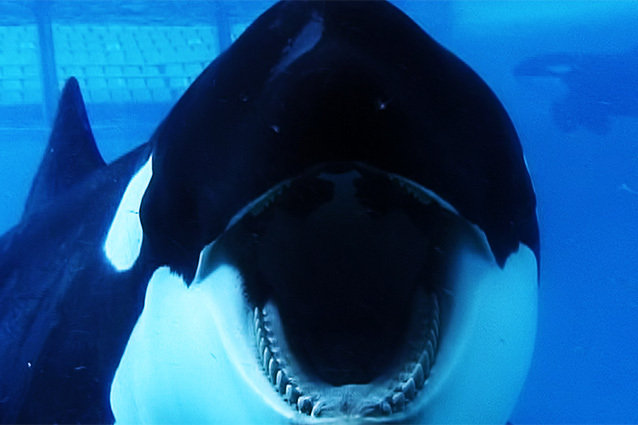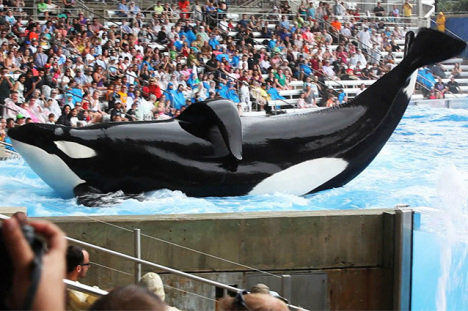
Gabriela Cowperthwaite’s documentary Blackfish has only been out for a few days, but it’s already causing quite a stir. As it should. Inspired by the death of SeaWorld trainer Dawn Brancheau in 2010, the powerful documentary exposes some of the atrocities committed by companies like SeaWorld as part of their practice of keeping killer whales in captivity. Through a series of interviews with former SeaWorld trainers, hunters, academics, and other whale experts, Cowperthwaite paints a grim picture of life for orcas in marine mammal parks.
Specifically, Blackfish focuses on Tilikum, the giant orca whale famous for having been involved in three human deaths (most notably that of trainer Dawn Brancheau at SeaWorld Orlando). Captured by hunters as a baby and kept in a dark, cramped tank environment for most of his life, Tilikum was brutally bullied by other whales in captivity, growing to have issues with aggression. But Blackfish isn’t a thriller about whales gone wild. Rather, it’s an unsettling tell-all about the consequences of imprisoning sea creatures.
As we learn in the documentary, orca whales are highly intelligent, family-oriented creatures that possess an extra part of the brain that humans don’t have. Because of their complex brains and social nature, killer whale captures and SeaWorld’s practice of separating young whales from their mothers are horrific for all parties involved. One former SeaWorld trainer describes an occasion on which she witnessed a young whale ripped away from its mother to be moved to a different park. After the incident, the mother whale exhibited a new sound pattern that her trainer had never heard before. The drawn out, wailing sound, which she said could only be described as “grief,” persisted for weeks.
Another notable testament to the orca whale’s intelligence and family ties comes in the form of an interview with a former whale hunter. Teary-eyed, the hunter describes the sight of a family of whales, helplessly bobbing on the surface of the ocean as they watched one of their babies lifted into a boat and carried away. The whales would remain in the same place for hours and even days, grieving the lost young one. The hunter refers to his former profession as “the worst thing that I’ve ever done.”
With scenes like this, it’s clear that Blackfish, like other documentaries, has a way of manipulating our emotions to further its cause. But when it boils down to it, the science in the film is evidence enought: SeaWorld’s practice of keeping orca whales in captivity is detrimental to the animals’ well-being. Either something needs change, or everything needs to stop.

But what can change? Perhaps the company could build larger tanks for the orca whales, but no man-made facility can compete with the vastness of their natural ocean environment. Maybe they could keep the whales in separate tanks to prevent the bullying and raking that’s all too common in captivity. But then again, killers whales are very social creatures, and depriving them of all contact with other whales would only make matter worse. Living in a bathtub is bad enough, but living in a bathtub all alone seems unimaginable. And as Blackfish shows us, Tilikum and other orca whales already live in pretty sad, unnatural environments.
The juxtaposition of footage of whales in poor conditions and the cheesy SeaWorld TV commercials from the ’80s and ’90s is fairly disturbing, but the truly sickening part is when Cowperthwaite exposes the blatant lies that SeaWorld feeds to the public about its captive animals. Footage of educational tours at the parks show guides telling their groups that orca whales live for about 20-30 years in captivity, which is much longer than they do in the ocean. A marine academic, however, quickly informs us that this couldn’t be further from the truth, as killer whales in the wild can live up to 100 years. Additionally, the tour guides tell the public that the floppy dorsal fins seen on SeaWord orcas are a common species trait, but in fact, less than 1% of killer whales in the wild have collapsed fins.
But perhaps the saddest takeaway from this movie is the realization that even after the infamous 2010 incident, Tilikum is still at SeaWorld, floating aimlessly in the confines of his tank and rarely performing in shows. It’s a sad life for the giant orca, and thinking about it makes us want to shout to the rooftops, “Free Tilly!” And it’s not just us. Oscar-winner Marion Cotillard had a similar response to the notion of killer whale captivity after she played a trainer in the 2012 film Rust And Bone: “I’d rather see whales in their own environment and not in a swimming pool. I will never go back to a SeaWorld.” After seeing Blackfish, neither will we.
If you’re interested in seeing Blackfish, click here to find a local screening near you.
Follow Caroline On Twitter @Carolinesb | Follow Hollywood.Com On Twitter @Hollywood_com
More:
‘Blackfish’ Is Anti-Whale Captivity, Trailer Is Just Anti-Whales
SeaWorld Officials Speak Out Against Blackfish
From Our Partners Battle of the Bikini Bodies (Celebuzz)
Battle of the Bikini Bodies (Celebuzz) Complete Guide to Strippers in Movies and TV (Vh1)
Complete Guide to Strippers in Movies and TV (Vh1)


